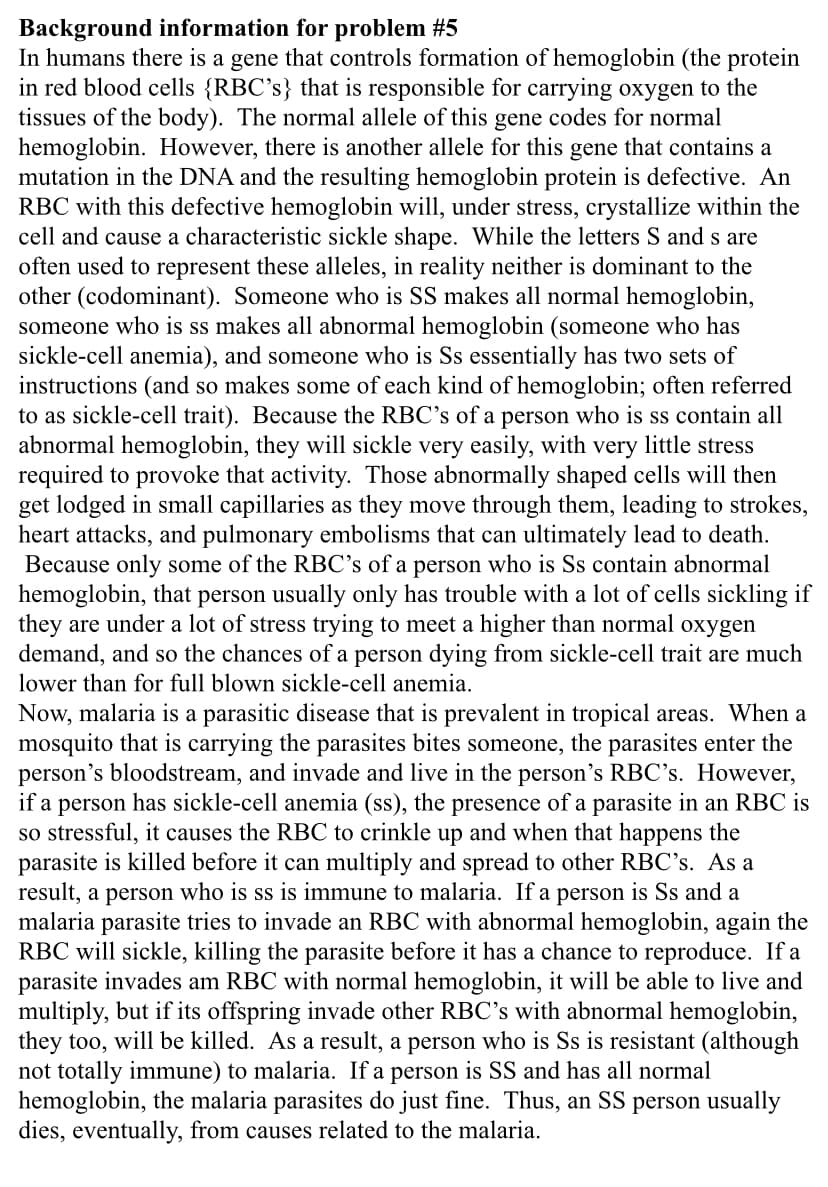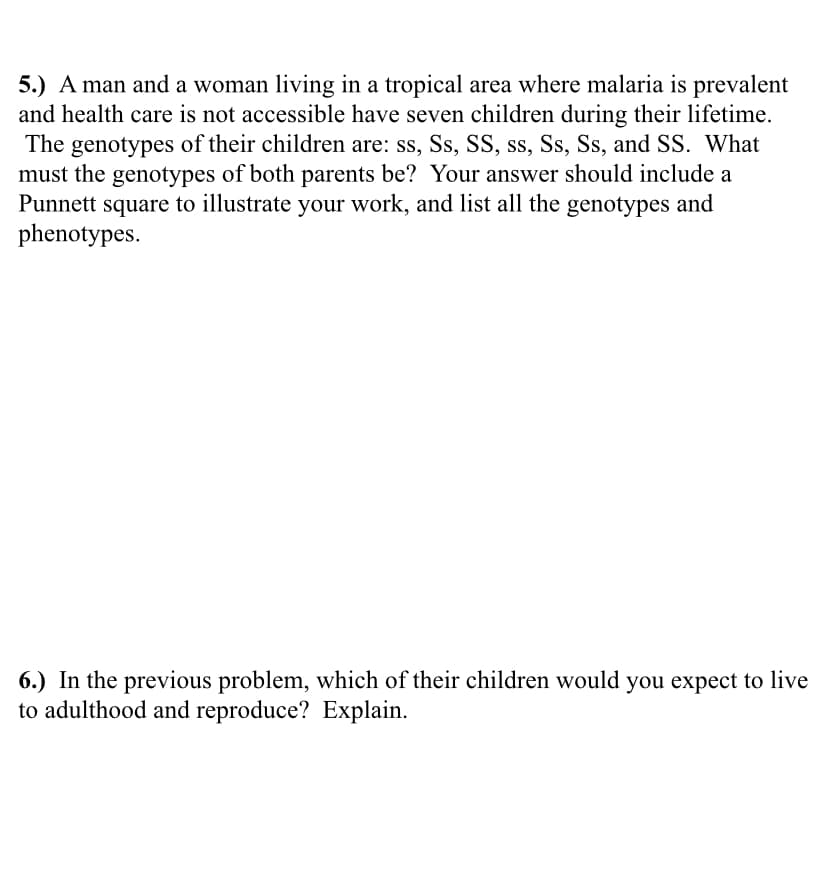5.) A man and a woman living in a tropical area where malaria is prevalent and health care is not accessible have seven children during their lifetime. The genotypes of their children are: ss, Ss, SS, ss, Ss, Ss, and SS. What must the genotypes of both parents be? Your answer should include a Punnett square to illustrate your work, and list all the genotypes and phenotypes. 6.) In the previous problem, which of their children would you expect to live to adulthood and reproduce? Explain.
5.) A man and a woman living in a tropical area where malaria is prevalent and health care is not accessible have seven children during their lifetime. The genotypes of their children are: ss, Ss, SS, ss, Ss, Ss, and SS. What must the genotypes of both parents be? Your answer should include a Punnett square to illustrate your work, and list all the genotypes and phenotypes. 6.) In the previous problem, which of their children would you expect to live to adulthood and reproduce? Explain.
Chapter8: Introduction To Cpt Coding
Section: Chapter Questions
Problem 9MC
Related questions
Question

Transcribed Image Text:Background information for problem #5
In humans there is a gene that controls formation of hemoglobin (the protein
in red blood cells {RBC's} that is responsible for carrying oxygen to the
tissues of the body). The normal allele of this gene codes for normal
hemoglobin. However, there is another allele for this gene that contains a
mutation in the DNA and the resulting hemoglobin protein is defective. An
RBC with this defective hemoglobin will, under stress, crystallize within the
cell and cause a characteristic sickle shape. While the letters S and s are
often used to represent these alleles, in reality neither is dominant to the
other (codominant). Someone who is SS makes all normal hemoglobin,
someone who is ss makes all abnormal hemoglobin (someone who has
sickle-cell anemia), and someone who is Ss essentially has two sets of
instructions (and so makes some of each kind of hemoglobin; often referred
to as sickle-cell trait). Because the RBC's of a person who is ss contain all
abnormal hemoglobin, they will sickle very easily, with very little stress
required to provoke that activity. Those abnormally shaped cells will then
get lodged in small capillaries as they move through them, leading to strokes,
heart attacks, and pulmonary embolisms that can ultimately lead to death.
Because only some of the RBC's of a person who is Ss contain abnormal
hemoglobin, that person usually only has trouble with a lot of cells sickling if
they are under a lot of stress trying to meet a higher than normal oxygen
demand, and so the chances of a person dying from sickle-cell trait are much
lower than for full blown sickle-cell anemia.
Now, malaria is a parasitic disease that is prevalent in tropical areas. When a
mosquito that is carrying the parasites bites someone, the parasites enter the
person's bloodstream, and invade and live in the person's RBC's. However,
if a person has sickle-cell anemia (ss), the presence of a parasite in an RBC is
so stressful, it causes the RBC to crinkle up and when that happens the
parasite is killed before it can multiply and spread to other RBC's. As a
result, a person who is ss is immune to malaria. If a person is Ss and a
malaria parasite tries to invade an RBC with abnormal hemoglobin, again the
RBC will sickle, killing the parasite before it has a chance to reproduce. If a
parasite invades am RBC with normal hemoglobin, it will be able to live and
multiply, but if its offspring invade other RBC's with abnormal hemoglobin,
they too, will be killed. As a result, a person who is Ss is resistant (although
not totally immune) to malaria. If a person is SS and has all normal
hemoglobin, the malaria parasites do just fine. Thus, an SS person usually
dies, eventually, from causes related to the malaria.

Transcribed Image Text:5.) A man and a woman living in a tropical area where malaria is prevalent
and health care is not accessible have seven children during their lifetime.
The genotypes of their children are: ss, Ss, SS, ss, Ss, Ss, and SS. What
must the genotypes of both parents be? Your answer should include a
Punnett square to illustrate your work, and list all the genotypes and
phenotypes.
6.) In the previous problem, which of their children would you expect to live
to adulthood and reproduce? Explain.
Expert Solution
This question has been solved!
Explore an expertly crafted, step-by-step solution for a thorough understanding of key concepts.
This is a popular solution!
Trending now
This is a popular solution!
Step by step
Solved in 2 steps with 1 images

Knowledge Booster
Learn more about
Need a deep-dive on the concept behind this application? Look no further. Learn more about this topic, biology and related others by exploring similar questions and additional content below.Recommended textbooks for you



